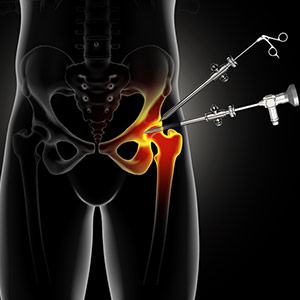- Anatomy
- Conditions
- Procedures
Total Hip Replacement

Total hip replacement is a surgical procedure in which the damaged cartilage and bone are removed from the hip joint and replaced with artificial components. The main indication for total hip replacement is arthritis. Arthritis is the inflammation of joints, which results in pain, swelling, stiffness and limited movement.
Hip Core Decompression for AVN

The hip joint is a ball and socket joint, where the head of the thighbone (femur) articulates with the cavity (acetabulum) of the pelvic bone. Sickle cell disease, a group of disorders that affect the hemoglobin or oxygen-carrying component of blood, causes avascular necrosis or the death of bone tissue in the hip due to lack of blood supply.
Hip Surgery

Hip surgery is a surgical procedure for the treatment of a hip injury or hip condition. The procedure involves repairing diseased or damaged structures of the hip joint in order to eliminate pain and restore normal hip function.
Hip Bursectomy

A hip bursectomy is a surgical procedure to remove an inflamed or irritated bursa in the hip. The bursa is a small fluid-filled sac that helps reduce friction between bones, tendons, and muscles. When it becomes inflamed (bursitis) due to overuse, injury, or underlying conditions like arthritis, it can cause chronic pain and limit mobility.
IT Band Tenotomy for Bursitis

Iliotibial (IT) band tenotomy for bursitis is a surgical procedure used to relieve pain and inflammation associated with iliotibial band syndrome (ITBS) or trochanteric bursitis (greater trochanteric pain syndrome). It involves making controlled incisions or lengthening the iliotibial band to reduce tension and friction over the greater trochanter of the hip.
Hip Fracture Surgery

Surgical correction of a hip fracture is known as hip fracture surgery. Hip fractures involve a break that occurs near the hip in the upper part of the femur or thigh bone. The thigh bone has two bony processes on the upper part - the greater and lesser trochanters. The lesser trochanter projects from the base of the femoral neck on the back of the thigh bone.
Hip Fracture ORIF

A hip fracture is a break that occurs near the hip in the upper part of the femur or thighbone. The thighbone has two bony processes on the upper part - the greater and lesser trochanters. The lesser trochanter projects from the base of the femoral neck on the back of the thighbone.
Femoral Nails

Femoral nails are metal rods used to align and stabilize fractured fragments of the femur or thigh bone. The rods are passed through the bone marrow at the center of the femur, across the fracture site. The rod is inserted through a small incision at either end of the bone and fixed at both ends with screws.
Hip Injections

Hip joint injections involve injecting medicine directly into the hip joint to diagnose the source of pain or treat pain due to conditions such as arthritis, injury or mechanical stress of the hip joint. Hip pain may be experienced in the hip, buttock, leg or lower back.
Hip Steroid Injections

Hip steroid injections involve administering medication through a needle into your hip joint to relieve pain and inflammation. Cortisol is a hormone that is naturally produced in the human body and functions to reduce stress and inflammation. Steroids are synthetic drugs that resemble cortisol and are used in treating joint pain.
Trochanteric Bursa Injections

A trochanteric bursa injection is a minimally invasive procedure in which medicine is injected directly into the trochanteric bursa in the hip joint using a thin needle and syringe to relieve pain and inflammation. The injection usually contains a combination of numbing medicine and cortisone (an anti-inflammatory agent).
Physical Examination of the Hip

The hip joint is a ball and socket joint. The ball is the head of the femur (thighbone) that fits in the acetabulum (the hip socket). Tendons, muscles, and ligaments hold the joint in place. Articular cartilage covers the acetabulum and the femoral head.












